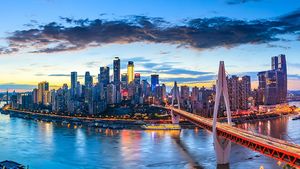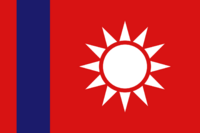Economy of Monsilva
 Amking is the capital and largest city in Monsilva and is the country's financial centre. | |
| Currency | Monsilvan yupian (MSY, ¥) |
|---|---|
| ₵1.00 : ¥6.03 | |
| 1 May – 31 April | |
| Statistics | |
| Population | 58,012,300 |
| GDP | |
GDP per capita | |
Main industries |
|
| External | |
Export goods |
|
All values, unless otherwise stated, are in Quebecshirite Credits (₵). | |
Percentage of Monsilvan GDP by Industry
Percentage of Monsilvan GDP by Sector
The economy of Monsilva is a highly developed social market economy which has developed as a result of economic growth and industrialization during the late 20th century. The sharp growth in the country's economy after the establishment of the republic in 1978, is known as the Monsilvan Miracle. As of Q1 2023, Monsilva is the 11th largest economy in Terraconserva, its high-tech and manufacturing industries playing a key role in the global economy.
Monsilva is a very large exporter, with its economy highly focused on exporting a wide range of goods. It is also an extremely globalised economy with a relatively high trade-to-GDP ratio. The service sector is the largest contribution to Monsilva's GDP; the project finance and investment is particularly important, with companies such as Yingtai International generating significant amounts for the economy through financing and investing in foreign projects. Closely following the service sector is the manufacturing sector. Monsilva manufactures a wide range of different products, including automobiles, one of Monsilva's largest exports; ships and other vehicles; pharmaceutical equipment; and electrical equipment.
Historically, Monsilva was a fairly isolated and agriculture focused economy, even during the early stages of industrialisation in the 18th century. Monsilva's economy only began to modernize and open up to the oustide world after the Monsilvan Civil War and the establishment of the Kingdom of Monsilva. During the early and mid 20th century, Monsilva developed from an agricultural economy to a manufacturing based economy, and later including services such as foreign investment and financial advice. In the late 20th century, Monsilva's economy grew massively, this period was the Monsilvan Miracle and resulted in a huge increase in the nation's GDP, HDI, gini and multiple other economic and political developments.
Contents
Sectors
Agriculture
Although not as major as it once was, the agricultural industry in Monsilva is still extensive, with the country producing around 52% of its food needs. This percentage peaked in the early and mid 1970s, with over 90% of food needs being supplied by Monsilvan products. Just under two-thirds of the value is devoted to arable crops such as rice and wheat. While just over a third is for livestock such as pigs, cows and chicken.
Production industries
Energy
During the revolutionisation of industry throughout the 19th century, coal, oil and natural gas were massive industries that provided the entirety of Monsilva's energy until the 1960s, when nuclear power began to grow significantly. By 1980, nuclear power placed third amongst the sources of energy consumed in Monsilva, causing the Monsilvan coal industry collapse in 1981. During the 1980s, the advocation for renewable and green energy began to grow and soon became a part of politics. In 1991, Monsilva introduced its first renewable energy law, stating it would move Monsilva towards renewable-only energy sources by 2030.
As of 2020, renewable energy accounts for 50% of total energy consumed in Monsilva, an increase of 10% from 2015. This places Monsilva short of their goal of 100% by 2030 if they continue at 10% every 5 years. The majority of this renewable energy is provided by hydroelectric energy, with nuclear energy coming a close second and wind energy coming third. The other 50% of Monsilva's energy consumption is provided by natural gas and oil.
Manufacturing
Over the last 40 years, Monsilva's manufacturing industry has become increasingly important to the country's economy. In 2018, it accounted for around 30% of the economy, making it one of the largest sectors of the Monsilvan economy.
The automotive industry, including automobile manufacturing, is the largest of the manufacturing industries in Monsilva, with companies such as Chienrú, Dayu Motors and Mingyang dominating Monsilva's automobile market and also having significant popularity in many other countries across Terraconserva. Closely related to the automotive industry, the locomotive and railway industry is also extremely important to the Monsilvan economy. Companies such as Fushao Rail and the Soong Railcar Manufacturing Company have a major influence over the global railway industry and are at the forefront of modern railways.
The shipbuilding industry is also very important to the Monsilvan economy. Soong Shipbuilding Corporation, Wantao Industries and Kuohai Shipbuilding Corporation are examples of major Monsilvan shipbuilding companies that not only provide ships, naval and marine equipment for civil and military services in Monsilva but also for other countries in Terraconserva. Monsilva's aerospace industry has significantly shrunk since the mid-20th century, however it is still prevalent, with the largest aerospace companies being AVIC Monsilva, the Soong Aerospace Company and the Monsilva Aerospace Exploration Agency. Other companies such as Fushao also produce parts for air and space craft.
Other major manufacturing industries in Monsilva include the pharmaceutical industry which is lead by companies such as Banpo Inc; electronic systems and machinery industry which is lead by Fushao; and the consumer products industry which is lead by a wide range of different companies across Monsilva.
Raw materials
Monsilva is rich with different natural resources such as bauxite (aluminium), silicon, tungsten, copper, zinc and mercury. The mining industry in Monsilva has shrunk massively over the last 30 years, with many of Monsilva's former major mining industries having shut down or moved on to other ventures such as renewable industry. However, it still contributes a significant amount to the Monsilvan economy.
Information technology
Over the last 20 years, Monsilva has played an important role in the worldwide IT market. Before the establishment of the republic in 1978, Monsilva's tech industry was more or less nonexistent. However during the Monsilvan Miracle and the country's rapid modernization during the 1980s and 90s, the tech industry also rapidly grew as well. Major tech companies in Monsilva include SCTC, one of Terraconserva's largest semiconductor manufacturing companies; Tsujin Software, the largest personal hardware and software company in Monsilva which has dominated the Monsilvan PC market by making the first Monsilvan-language operating system; Bujin, an international consumer electronics and online services provider; and Njidu Corporation, a major software and fabless technology company famous for its graphics processors which produces billions of computer parts annually.
As well as domestic companies, Monsilva is also a haven for many international technology and telecommunications companies wishing to outpost in Ostlandet thanks to the country's moderately unrestrictive tax laws on foreign companies and minimal government interference.
Significant products produced by Monsilva's IT industry includes: Leeting, a messaging app originally designed just for Monsilva but has expanded globally but with most of its popularity being found in central Ostlandet; Shifu Pay, a major financial technology company which operates online payments and money transfers; TKT and Pengyu Ka, which are both major Monsilvan-language social media apps. Another massively popular app originating in Monsilva was the controversial social media, TicTac, which gained significant popularity globally but ended up being banned in a large number of countries due to privacy concerns which eventually led to its demise in February 2021.
Financial and business services
Financial and business services make up one of the largest portions of the Monsilvan economy, and is the largest industry in the service sector. Major Monsilvan banks include the Bank of Monsilva and ALBC. As well as being a centre for international business, it is also home to multiple international project finance and development companies which make significant earnings through investing and financing minor and major infrastructure projects in and outside of Monsilva. The largest of these companies is Yingtai International which has contributed to the construction of two foreign national railways and a metro network as well as multiple nuclear power plants in Monsilva.
Transport, storage and communication
The transportation and storage industry is important to the Monsilvan economy. Public transportation in Monsilva is mostly nationalized, with the Monsilvan Railways Administration, which provides most of Monsilva's main national railway services being owned by the Monsilvan government. Other railway networks such as Western Railways Administration and Federal North Railway are operated as a joint ownership by the state governments of the states the services run through. Metro networks such as the Amking Metro are also usually owned by a city council, county council or state government.
Monsilva's highways are under the responsibility of the National Highway Company which manages trunk roads, highways and tolls. Individual states have their own highway companies which manage in-state highways and major roads, however these companies are all branches of the National Highway Company.
In 2022, Monsilva's airports handled a total of 227 million passengers, with Xu Zhou-da International Airport in Amking receiving around 62.6 million of that. Other major airports in Monsilva include Luhai Qingdao Airport (~46.7 million), Menchi Qianzhen Airport (~29.4 million) and Zhangye Tanxi Airport (~20.5 million).
Tourism
Millions of people visit Monsilva every year, with the majority of these tourists heading to Monsilva's major cities. The capital, Amking, is one of the most visited cities in the world. In 2019, a survey of tourists in Monsilva attempted to determine reasons for Monsilva's large numbers of tourists, the results included phrases such as "a unique culture", "different traditions" and "historical atmosphere".
Monsilva's 10 most significant inbound tourism markets in 2022:
| Rank | Market | Visitors |
|---|---|---|
| 1 | 23,680,000 | |
| 2 | 2,775,000 | |
| 3 | 962,000 | |
| 4 | 851,000 | |
| 5 | 370,000 | |
| 6 | 333,000 | |
| 7 | 281,200 | |
| 8 | 273,800 | |
| 9 | 188,700 | |
| 10 | 151,700 |
Wholesale and retail trade
This sector includes the motor trade, auto repairs, personal and household goods industries. Retail is a major part of many economies and that does not leave out Monsilva. Small business traditions are viewed very highly which has made the establishment of chain retail stores difficult to achieve in Monsilva, especially before the introduction of international chains.
The Monsilvan grocery market is dominated by: LM Mart, which operates two brands: Lian-Mian and Hualian; and InfiMart; with the rest of the market share being mostly made up of international and smaller chain stores.
Currency
The currency of Monsilva is the yupian, represented by the symbol "¥". The Bank of Monsilva is the central bank, responsible for issuing currency.
₵1.00 = ¥6.03
